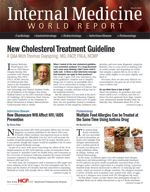Joining the Group Improves Hypertension Control
Researchers associated with US Department of Veterans Affairs medical centers have examined the impact of group medical clinics on lipid control among patients with uncontrolled hypertension.

Group medical clinics are beginning to demonstrate improved outcomes for patients with a number of conditions, including hypertension and asthma. In this model, a care team comprised of a general internist, pharmacist, and certified diabetes educator meets with 7-9 patients for 2 hours every 2 months for 1 year.
Researchers associated with US Department of Veterans Affairs (VA) medical centers recently examined the impact of group medical clinics on lipid control among patients with uncontrolled diabetes and hypertension. For their study published in the February 2014 issue of the American Journal of Medicine, the authors randomized 239 veterans to group medical clinics or usual care and assessed lipids at the trial’s baseline, midpoint, and end.
At baseline, mean total cholesterol was 169.7 mg/dL, while low-density lipoprotein cholesterol (LDL-C) was 98.2 mg/dL, and high-density lipoprotein cholesterol (HDL-C) was 39.3 mg/dL. Median baseline triglycerides were 131 mg/dL.
At the end of the study, the veterans who were randomized to group medical clinics had mean total cholesterol and LDL-C levels that were 14.2 mg/dL and 9.2 mg/dL lower than those of the veterans assigned to usual care, respectively. Approximately three-quarters of veterans in the group medical clinic arm met LDL-C goals, compared to 61% of the usual care patients. However, triglycerides and HDL-C remained similar between the 2 study arms.
Roughly half of the veterans in the group medical clinic arm experienced treatment intensification with cholesterol-lowering agents, compared to only 37% of those in the usual care group. Accordingly, the veterans who assigned to the group medical clinic had higher mean statin doses, which reflected more attention to medications and response.
The authors indicated greater medication intensification might explain the superior cholesterol-lowering outcomes attained through group medical clinics, which they suggested counteract clinical inertia in lipid management. Overall, the group medical clinics supplemented expert medication management with comprehensive patient education to help patients self-manage their lipid levels.
